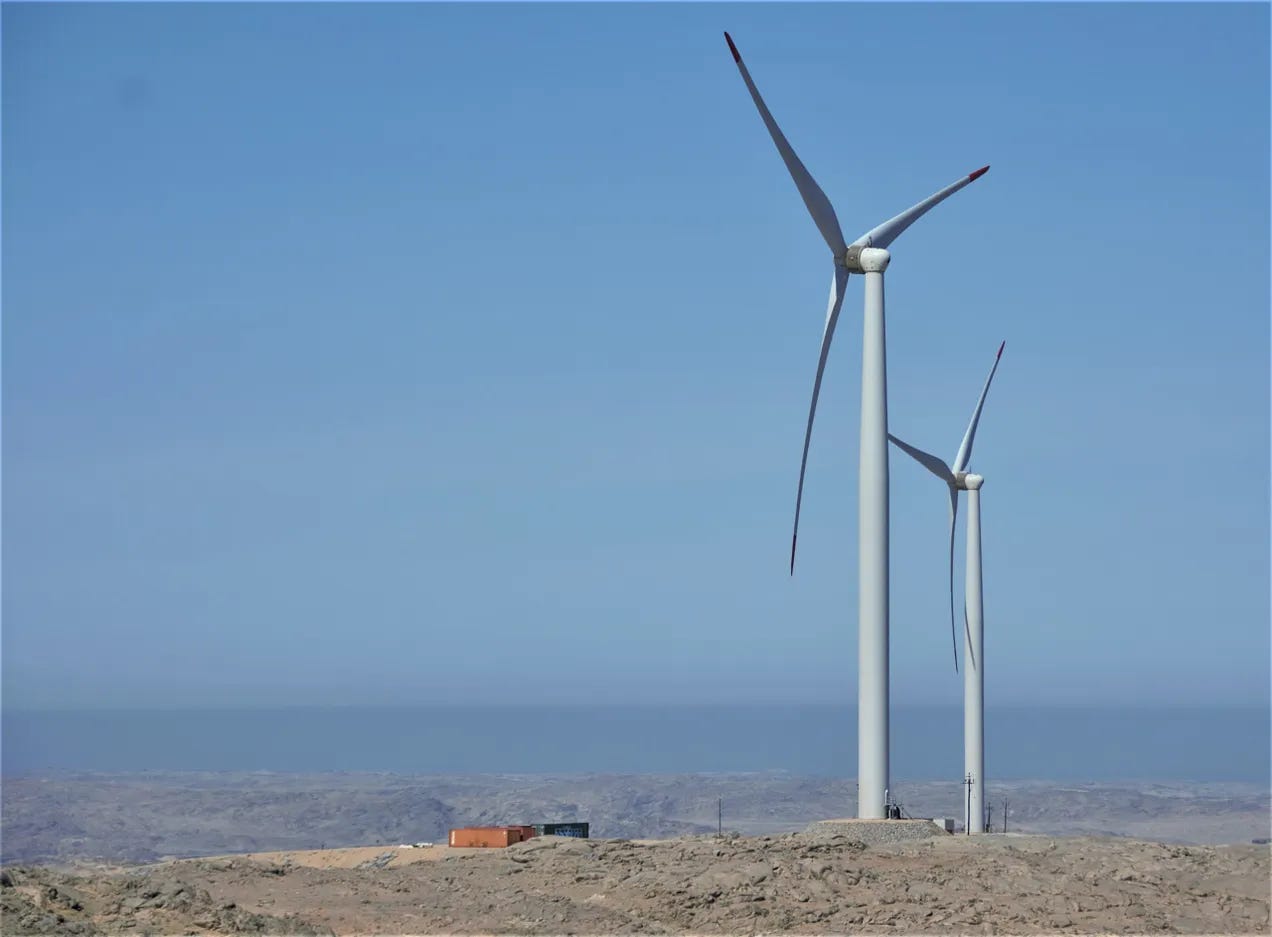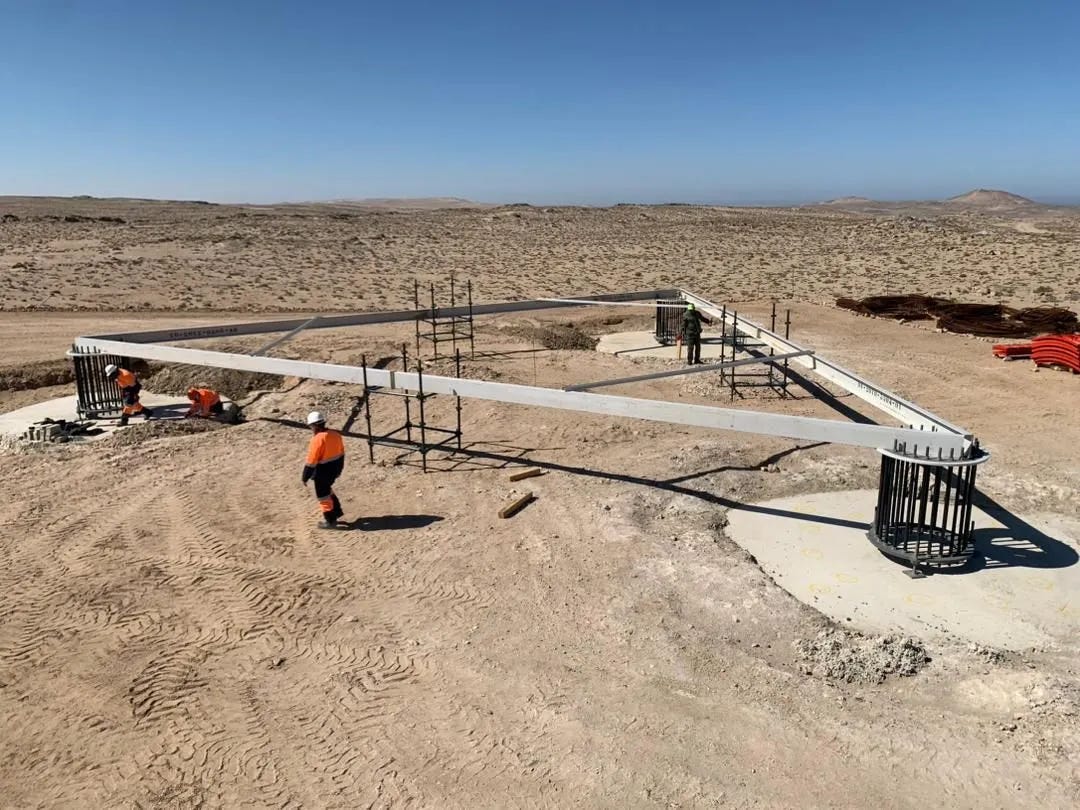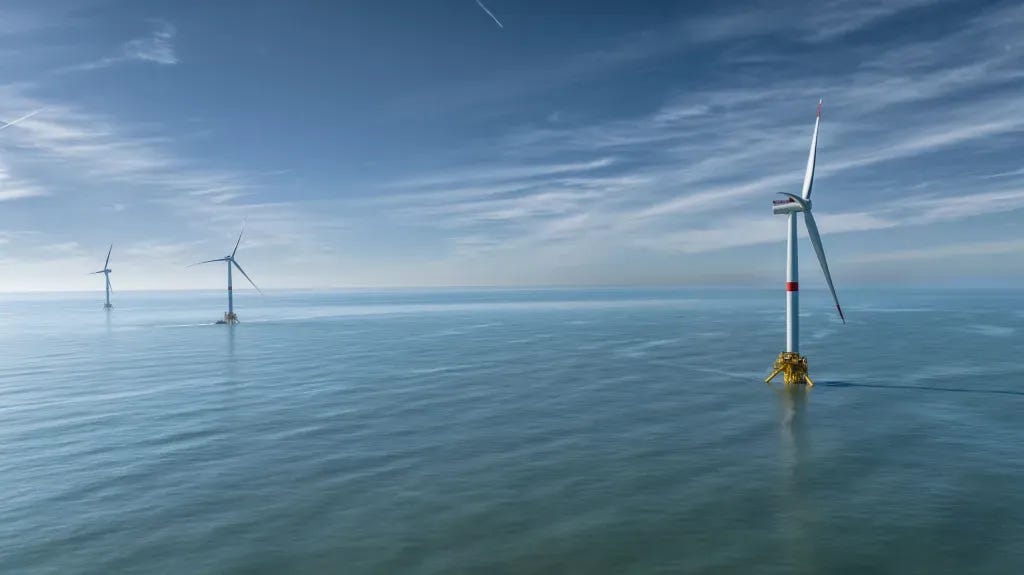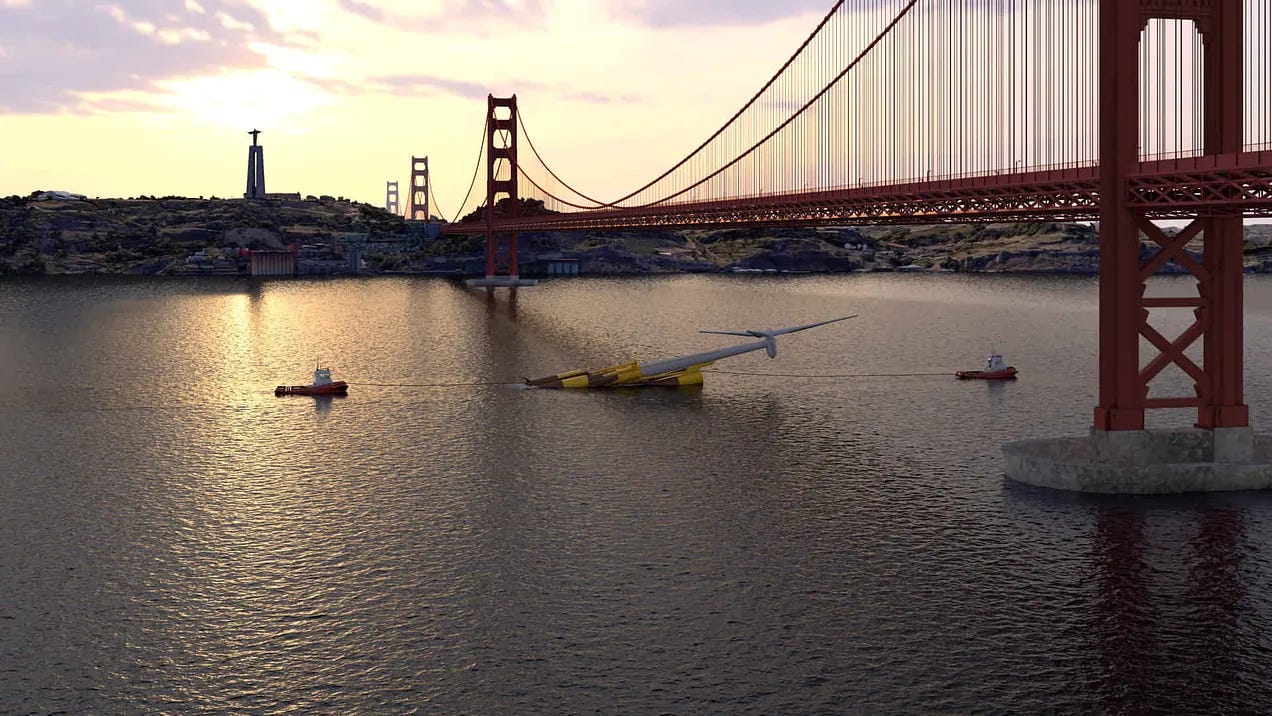Windletter #97 - Bringing wind energy to Namibia
Also: Aikido builds its first floating prototype, WindEurope 2026 heads to Madrid, the first GE 3.6 MW-154m, and more.
Hello everyone and welcome to a new issue of Windletter. I'm Sergio Fernández Munguía (@Sergio_FerMun) and here we discuss the latest news in the wind power sector from a different perspective. If you enjoy the newsletter and are not subscribed, you can do so here.
Windletter is sponsored by:
🔹 Tetrace. Specialized services in operation and maintenance, engineering, supervision, inspection, technical assistance, and distribution of spare parts in the wind sector. More information here.
🔹 RenerCycle. Development and commercialization of solutions and specialized services in the circular economy for renewable energies, including comprehensive dismantling of wind farms and waste management, refurbishment and sale of components and wind turbines, management and recycling of blades and others. More information here.
Windletter está disponible en español aquí
The most-read topics from the last edition were: the video of the offshore CTV transfer, the cable-stayed rotor of Vestas, and the post to understand how a wind turbine operates just by looking at its blades..
Now, let’s dive into this week’s news.
🌍 Innovent brings wind energy to Namibia
I was doing my usual news roundup to prepare Windletter when I came across Nabrawind Technologies' announcement about using their Nabrabase solution for four foundations at the Diaz wind farm in Namibia.
Currently under construction, the Diaz wind farm consists of 11 wind turbines of 4 MW each, totaling 44 MW. The specific model is unknown, but if I had to guess, I’d say it’s from a Chinese OEM.
The project developer and Nabrawind’s end client is, as usual, the French IPP Innovent, which has relied on the solutions from this company based in Navarra for several of its wind farms.
What caught my attention the most about the project, beyond its innovative foundations, was its location. Namibia didn’t strike me as a country with much wind energy development, so I decided to dig deeper.
And indeed, I was right. In a country with 2.6 million inhabitants and electricity access at just around 50%, it’s not surprising that there are only two wind farms:
ErongoRED, consisting of a single turbine from the now-defunct Danish manufacturer Wind World, model W2500/220, with a capacity of 220 kW and a rotor diameter of 25 meters. I’m not sure this even qualifies as a wind farm.
Ombepo, with three XEMC-Darwind XE93-2000 turbines of 2 MW and a rotor diameter of 93.4 meters. Its owner is also Innovent, and the Diaz wind farm is being installed next to it, near the city of Lüderitz.
A new addition to these installations is the Diaz wind farm, located south of Lüderitz, close to the Ombepo wind farm (I believe I’ve pinpointed the location of the meteorological mast here).
The Lüderitz area boasts an extraordinary wind resource. According to NamPower, the country’s national utility, in this document, wind speeds average over 9 m/s.
According to Innovent, this resource will enable the wind farm to achieve approximately 5,000 equivalent full-load hours, with an annual production of over 230 GWh. This figure represents between 5% and 6% of Namibia’s total electricity consumption and will significantly reduce the need to import electricity from South Africa (currently accounting for 60–70% of total consumption).
The environmental impact study is available on Innovent’s website.
Returning to the construction of the wind farm, the Nabrabase solution is particularly well-suited for locations like this, with rocky terrain and scarce water and concrete, which can complicate conventional foundation execution.
According to Nabrawind, this system requires 80% less concrete than a standard foundation and significantly less steel. The solution is similar to the one used in the Le Portel wind farm, where a Vensys 3.8-126 turbine was installed.
Construction began in 2023, with commissioning scheduled for July 2025.
Innovent has a strong presence in Namibia, with 26 MW operational since 2015 and a local team of 18 people managing the operation and development of solar and wind assets. The French company also plans to commission a 10 MWp photovoltaic plant in April next year.
Developing, building, and operating assets in a country like Namibia must be challenging, but this is undoubtedly great news for reducing the cost of electricity access by leveraging renewable resources.
🌊 Provence Grand Large, the pilot floating wind farm with 3 turbines located in France, connects to the grid
We have mentioned the pilot wind farm Provence Grand Large several times, composed of 3 x SG 8.0-167 DD turbines of 8.4 MW each, which is the first floating wind farm in France.
Well, after a long period of construction, installation, and commissioning, the park has finally fed its first megawatt-hours into the grid.
Located 17 kilometers off the coast in the Mediterranean Sea, the turbines are anchored at a depth of about 100 meters and float on TLP (Tensioned Leg Platform) platforms.
France also has another similar wind farm under construction, Eolmed, which is also floating and composed of 3 units of the Vestas V164-10.0 MW, mounted on a BW Ideol barge-type floater.
Undoubtedly, the learnings from these pilot projects will be fundamental for France's upcoming offshore wind auction (AO9), where more than 1 GW of floating wind power will be auctioned.
🌬️ Aikido Technologies, backed by Bill Gates, builds the first prototype of its floating platform
Aikido Technologies is a U.S.-based startup founded in San Francisco in 2020 and backed by Bill Gates through Breakthrough Energy Fellows, a fund focused on innovation in the energy sector.
Aikido specializes in developing floating wind technology and has recently built its first 1:4 scale prototype, the Aikido One. Designed to host a 100 kW wind turbine, it was manufactured in Louisiana, United States.
The unique feature of this design is that it is a foldable platform that can be transported horizontally, allowing, according to Aikido, for optimized costs and production timelines.
According to the company, the design enables assembly, transportation, and loading in a way that existing infrastructures, such as barges and small ports, can be used. This increases the availability of ports and vessels that can participate in the offshore wind industry.
So far, the prototype has not been tested under real conditions, but Aikido is exploring opportunities to trial the technology and plans to launch a full-scale version by 2028.
Truthfully, this is the first time I’ve heard about Aikido. For some reason unknown to me, it had not come to my attention until now. You can check out their website for more information.
📉 Indexing offshore auction tariffs to material price trends
In recent times, due to international geopolitical instability and the pandemic, the price of raw materials has been quite volatile. One only needs to look at the price trends of steel, copper, or aluminum in recent years.
This volatility poses a significant risk in a sector like wind energy, particularly offshore, where a considerable amount of time can pass between signing a contract and when OEMs begin purchasing materials (or their suppliers do).
In fact, during the Covid-19 era, many Western OEMs attributed part of their losses to being unable to pass sudden raw material price increases onto already signed contracts.
One of the consequences of this was that many contracts began incorporating material price indexation clauses, allowing OEMs to pass this risk onto developers.
However, the risk does not disappear but rather shifts (at least partially) to the other party. This, in turn, complicates investment decision-making for developers, who now face a new risk in their analyses.
To address this, Japan's Ministry of Economy, Trade, and Industry (METI) is considering introducing a mechanism to adjust the prices of offshore projects awarded in auctions to reflect changes in material costs. Undoubtedly, an interesting proposal.
📍 Goodbye Bilbao. The WindEurope 2026 fair will be held in Madrid
As we hinted in Windletter… haha, I’ve always wanted to say that 😂
Jokes aside, and much to my regret, it is my duty to inform you that Madrid will host the WindEurope 2026 fair, meaning it won’t be returning to Bilbao. It’s a bittersweet moment: on one hand, it’s a shame we won’t enjoy the fair in Bilbao (and as someone from Bilbao, it stings), but on the other hand, the event remains in Spain and not too far from home (some might say it’s just the outskirts of Bilbao 🙂).
This was something we knew could happen and, in fact, we discussed it in the conclusions of WindEurope 2024, which we published here.
The truth is that Bilbao did show some signs of strain, pushing its capacity to the limit during an edition that brought in no less than 12,000 attendees last year and continues to grow with each edition.
Well, it is what it is. The only thing I can promise is that I will do my best to ensure Windletter is there. Although we’ll have to wait a bit.
The event will take place at IFEMA from April 21-23, 2026. More information is available on WindEurope’s website.
🇨🇳 The CEO of BlueFloat Energy visits Mingyang
We’ve been discussing the potential entry of Chinese manufacturers into Europe for some time, particularly Mingyang’s move into the European offshore wind sector.
More and more signs suggest that this is something that will happen sooner rather than later:
Named preferred supplier in Germany by developer Luxcara.
Issues at GE Vernova (which has effectively put its offshore business on hold until further notice), reducing competition to Vestas and SGRE and encouraging developers to explore alternatives.
The Scottish Offshore Wind Energy Council (although Scotland is not in the EU) considers it strategic Mingyang to open a factory in the country.
A preliminary agreement with Italian developer Renexia for 2.8 GW of floating wind and a nacelle factory in Italy.
A visit by RWE management to Mingyang’s facilities.
The latest development to add to this list is the recent visit by BlueFloat Energy’s CEO, Carlos Martin Rivals, to the Chinese OEM’s facilities.
As Carlos posted on LinkedIn, the purpose of the visit was the "search for tangible and realistic solutions to address supply chain challenges for our advanced offshore wind project portfolio in Europe and APAC."
Moreover, Mingyang stands out in floating wind, with its strong commitment to R&D and its iconic double-rotor OceanX prototype. BlueFloat also has a significant portfolio in this sector.
The BlueFloat delegation also visited Seatrium in Singapore and Dajin Heavy Industry in China.
🌵 GE Vernova installs the first GE 3.6 MW-154m turbines at SunZia, one of the largest projects in the United States
The SunZia project is arguably the largest wind farm in the “Western Hemisphere”. In this very newsletter, we referred to it as one of the largest onshore contracts in history.
Located in the New Mexico desert and developed by Pattern Energy, the project involves deploying 674 units of the GE 3.6-154, the latest model from the American company optimized for low wind speeds, totaling 2,400 MW.
This model is specific to the U.S. market and falls under the category of high-capacity-factor turbines, characterized by their low power density (large rotor, low nominal power).
It’s a turbine concept increasingly common worldwide, as it allows the exploitation of locations with lower wind speeds while capturing higher revenues in the electricity market by generating when others are not.
GE has produced a short documentary on this project, which marks the first installation of the GE 3.6-154. These turbines are being manufactured in Pensacola, Florida, and transported to their final site in New Mexico.
The video is worth watching, as it shows detailed factory operations, transportation (the nacelle is notably compact), and discussions about the prototype of this model.
As if that weren’t enough, once completed, SunZia will have a total of 3,500 MW. The remaining 1,100 MW of the project has been awarded to Vestas, which will supply a very different turbine: the V163-4.5 MW, with 242 units from the Danish manufacturer.
Thank you very much for reading Windletter and many thanks to Tetrace and RenerCycle, our main sponsors, for making it possible. If you liked it:
Give it a ❤️
Share it on WhatsApp with this link
And if you feel like it, recommend Windletter to help me grow 🚀
See you next time!
Disclaimer: The opinions presented in Windletter are mine and do not necessarily reflect the views of my employer.












